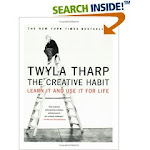
etching 117mm x 92mm
It is so easy to get stopped in one's tracks by failure. Yet as JK Rowling and many other successful and talented people have pointed out, failure has its own particular benefits and being willing to risk and engage with failure is vital to any creative endeavour.I was both moved to tears and inspired by JK Rowling in her wonderful Harvard commencement address in which she explained that failing on an epic scale had stripped away the inessential leaving her to put all her energy into the one thing she was good at. (Thanks to Christine Kane for alerting me to this goodie)
Many wise teachers have understood the importance of not being afraid to fail. Among them, Randy Pausch, when he was virtual reality tutor at Carnegie Mellon, gave his students the First Penguin Award for the most spectacular failure - an award the other students knew was an honour for daring to think outside the box.
In a Recipe for Dreaming, Bryce Courteney writes, "you will learn more from a brilliantly executed failure than from a success planned within the dreary safety of what you already know."
Twyla Tharp in her book The Creative Habit writes a whole chapter on failure. Like Rowling she says failure "cleanses. It helps you to put aside who you aren't and reminds you who you are."
In a useful exercise Tharp breaks down failure into five categories - it's worth reading the whole chapter, but here is a precis:
1. Failure of skill > take the time and make the effort to develop the skills you need.
2. Failure of concept > start again
3. Failure of judgement > be wary of telling yourself - it's just fine - when you know in your gut it isn't.
4. Failure of nerve > let go of the fear of looking foolish.
5. Failure through repetition > don't try and repeat past successes - allow yourself to move on.
My own epiphany with failure came when I realised the importance of scaffolding. After a house has been built, the scaffolding is removed, you don't see it - and yet it was an essential part of the process. Likewise, ecologists trying to restore, say a wild prairie, are running into difficulties because certain species have disappeared completely and yet they were essential to arriving at the final ecosystem. From the individual species point of view, this is failing - looking at the bigger picture, they were part of the scaffolding that led to the wild prairie. Failure is scaffolding.
This partly explains why comparison with other artists can be deadly. When I look at someone else's creative success what I don't see are the failures it took to get there. Now, when I try new things out in the studio, or in my writing, I avoid thinking - this is the final thing, this has got to work or, this is going to be the great success. I approach it like this - so, I've got a hunch to do it this way and it seems maybe a little odd or at least unexpected, but I'm going to trust myself and try it out because even if it doesn't work, who knows where it will lead?
If I look at my favorite pages in the picture book I'm working on, they are all a third or fourth try and I wouldn't have got there if I hadn't had those 'failures' to build upon along the way. I've also tried picture books before and 'failed'. There are at least half a dozen starts in boxes and sketchbooks that didn't work out. Yet now I see that many of the ideas contained in those 'failures' are essential to this project which is coming together in a way I'm really happy about.
Failure is scaffolding, it means you are building something, trying things out, learning what works for you and what doesn't. The important thing is not the 'failure', it's using the lesson contained within to take the next step.










1 comment:
What a great post and reminder to take creative (and other) failures as lessons. I just finished reading Twyla Tharp's book and was struck, too, by the wisdom of this chapter. I am so glad to have found your blog-- your writing is beautifully thought-out and thought-full.
Post a Comment